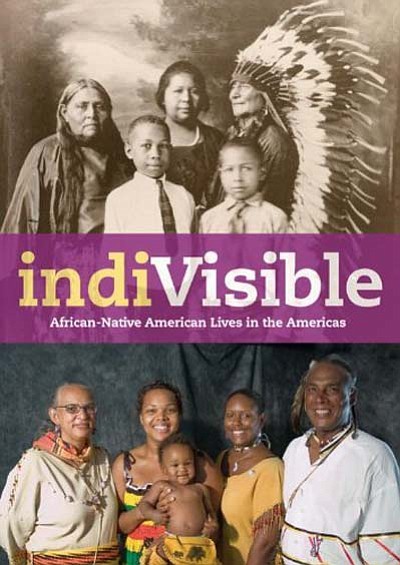InDivisible: African-Native American Lives in the Americas
Black Indians have often been typified as "wannabees" or "Black folks just wanting to be Indian." InDivisible: African-Native American Lives in the Americas examines the history of blended identities, how this history was shaped by politics and slavery, and where we stand as a nation today on this issue.
This beautifully illustrated book, featuring the words of 29 scholars, curators, historians and more, raises important questions about how we as Americans view ourselves, and our basic human right to identify ourselves.
The 2007 revocation of tribal membership from 2,800 Cherokee Freedmen brought this issue to very public attention. Chad Smith, Cherokee principal chief, argued that the move had nothing to do with race, but of who can be an Indian in an Indian Tribe, Mark Hirsch recounted. Smith asserted that, "The right to define tribal membership lies at the core of tribal identity and self-government."
The issue of the Cherokee Freedmen stands as a blatant example of how slavery has shaped not only how White Americans, but Native Americans, look at people with Black ancestry. The attacks on 1997 Miss Navajo Radmilla Cody, both in person and in the press, were shocking to many who believe that we as Americans are beyond such racism. Even the U.S. Census asks citizens to identify their race.
"As articulated by its framers in 1787, the purpose of the census was to determine apportionment of political power based on population, and tax responsibility based on wealth," notes Dr. Angela A. Gonzalez.
Gonzalez examines what purpose the federal government held for sorting people by race.
"In the United States-in its continuous history, until recently, of placing its entire population into mutually exclusive 'races'-people were pigeonholed into official government divisions, which gave legitimacy to these divisions and to the racialized modes of thinking inherent in them," Gonzalez concludes.
Gonzalez goes on to say that recognizing that the census has been "influential in creating and manipulating identities" requires understanding of the role it has played in "constructing American Indian and African American individual and collective self-understanding and identity." Basically, we are asked to understand how being classified in categories set by our government has offered up guidelines for how a people or persons is to perceive themselves and each other.
History itself has been literally "Blacked out" according to curator, writer and scholar Bethany Montagano. She looks to the art world to prove how history is visibly altered to, as she suspects, cater to the whim of government or popular opinion.
"In many cases, the histories and shared experiences of African and Native Americans are so intertwined, they are indivisible. At the same time, however, the shared history and the people that make up its chapters have become invisible," she writes.
She offers a print, a photograph taken by August Schoefft, entitled "Kickapoo to the Emperor's Court (circa 1865)." Centered in this picture of Kickapoo Indians are, clearly, two men of African descent who have also come to visit Emperor Maximilian of Mexico. Montagano contrasts the print with Schoefft's painting, "Six Kickapoo Indians, Chief and Family," removes the Black Indians from the scene.
Montagano convincingly identifies the Black Indians in the photograph as Black Seminoles, and probably leader John Kibbetts and his son, Robert Kibbetts. She goes on to refer to other paintings that do include the Black Seminole leader, however points out how his changed position suggests inferiority and subservience. Montagano explores the rationale behind the artistic alteration of history.
"After looking at Schoefft's work, one can't help but wonder how often these kinds of omissions occurred. Was it common practice to overlook black agency in Native life, culture and history?" Montagano asks. She goes on to conclude that "Whatever the motivations of the artists...it is clear that the widely held stereotypes of the mid-nineteenth century distorted the reality of that moment in history. The members of the delegation were depicted through a lens of racial prejudice common to that era, and not as they saw themselves."
Scholars like Dr. Jack Forbes and Dr. Robert Keith Collins insist that the right to self identification belongs not only to groups but to individuals.
InDivisible was published by the Smithsonian Institution's National Museum of the American Indian in association with the National Museum of African American History and Culture and the Smithsonian Institution Traveling Exhibition Service and describes the work succinctly.
"Through the concepts of policy, community, creative resistance, and lifeways, InDivisble: African-Native American Lives in the Americas examines the long overlooked history of Native American and African American intersections."
SUBMIT FEEDBACK
Click Below to:




